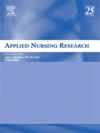Use of multimedia shared decision-making aids (EATING program) for improving advance care planning engagement among community-dwelling older adults with chronic diseases: A cluster randomized controlled trial
IF 2.7
4区 医学
Q1 NURSING
引用次数: 0
Abstract
Background
Discussing advance care planning (ACP) preferences for nasogastric tube (NG) insertion remains challenging among older adults. Multimedia decision-making aids have demonstrated potential to enhance understanding and support informed decision-making.
Aim
To evaluate the effectiveness of the EATING program (multimedia decision-making aids + traditional educational module) compared to usual care (traditional educational module alone) in improving ACP readiness on NG insertion for community older adults with chronic illness.
Methods
A single blind, two-arm parallel cluster randomized controlled trial was conducted across four community villages in Northern Taiwan. Participants from two villages received the EATING program, while the other two villages received the usual care. Eligible criteria included community older adults aged ≥65 with at least one chronic disease who were able to provide informed consent. Exclusion criteria included hearing or visual impairments or a history of mental illness. Pre- and post-intervention outcomes, along with one-month follow-up data, were analyzed using descriptive statistics and generalized estimating equations.
Results
Both groups showed significant immediate improvements in knowledge (p < 0.001), belief/behavior (p < 0.001), decision confidence (p < 0.001), and readiness for ACP (p < 0.001). The experimental group showed greater improvement, particularly in emotional response and preferences (Z = -5.51, p < 0.001), observed only in this group. Sustained effect on knowledge (B = 35.029, p < 0.001), emotional response and preferences (B = 9.342, p < 0.001), refusal NG tube insertion (Z = -2.770, p = 0.006), and likelihood of signing official documents (p = 0.035) were observed after one month.
Conclusion
The study highlights the potential of multimedia program to enhance NG insertion discussions among community older adults. Further qualitative investigations and cultural adaptation are recommended.
使用多媒体共享决策辅助(进食计划)改善社区居住的老年慢性病患者的提前护理计划参与:一项随机对照试验
背景:在老年人中讨论鼻胃管(NG)置入的预先护理计划(ACP)偏好仍然具有挑战性。多媒体决策辅助工具已显示出增强理解和支持知情决策的潜力。目的评价进食计划(多媒体决策辅助+传统教育模块)与常规护理(单独的传统教育模块)相比,在提高社区慢性病老年人植入术的ACP准备度方面的有效性。方法在台湾北部4个社区村进行单盲、双臂平行整群随机对照试验。来自两个村庄的参与者接受了饮食计划,而其他两个村庄的参与者接受了常规护理。入选标准包括年龄≥65岁且至少患有一种慢性疾病且能够提供知情同意的社区老年人。排除标准包括听力或视觉障碍或精神病史。使用描述性统计和广义估计方程对干预前后的结果以及一个月的随访数据进行分析。结果两组在知识方面均有显著的即时改善(p <;0.001),信念/行为(p <;0.001),决策置信度(p <;0.001), ACP准备情况(p <;0.001)。实验组表现出更大的改善,特别是在情绪反应和偏好方面(Z = -5.51, p <;0.001),仅在该组中观察到。对知识的持续影响(B = 35.029, p <;0.001)、情绪反应和偏好(B = 9.342, p <;0.001)、1个月后拒绝插入NG管(Z = -2.770, p = 0.006)、签署官方文件的可能性(p = 0.035)。结论本研究强调了多媒体节目在社区老年人中促进NG插入讨论的潜力。建议进一步进行定性调查和文化适应。
本文章由计算机程序翻译,如有差异,请以英文原文为准。
求助全文
约1分钟内获得全文
求助全文
来源期刊

Applied Nursing Research
医学-护理
CiteScore
4.50
自引率
0.00%
发文量
65
审稿时长
70 days
期刊介绍:
Applied Nursing Research presents original, peer-reviewed research findings clearly and directly for clinical applications in all nursing specialties. Regular features include "Ask the Experts," research briefs, clinical methods, book reviews, news and announcements, and an editorial section. Applied Nursing Research covers such areas as pain management, patient education, discharge planning, nursing diagnosis, job stress in nursing, nursing influence on length of hospital stay, and nurse/physician collaboration.
 求助内容:
求助内容: 应助结果提醒方式:
应助结果提醒方式:


